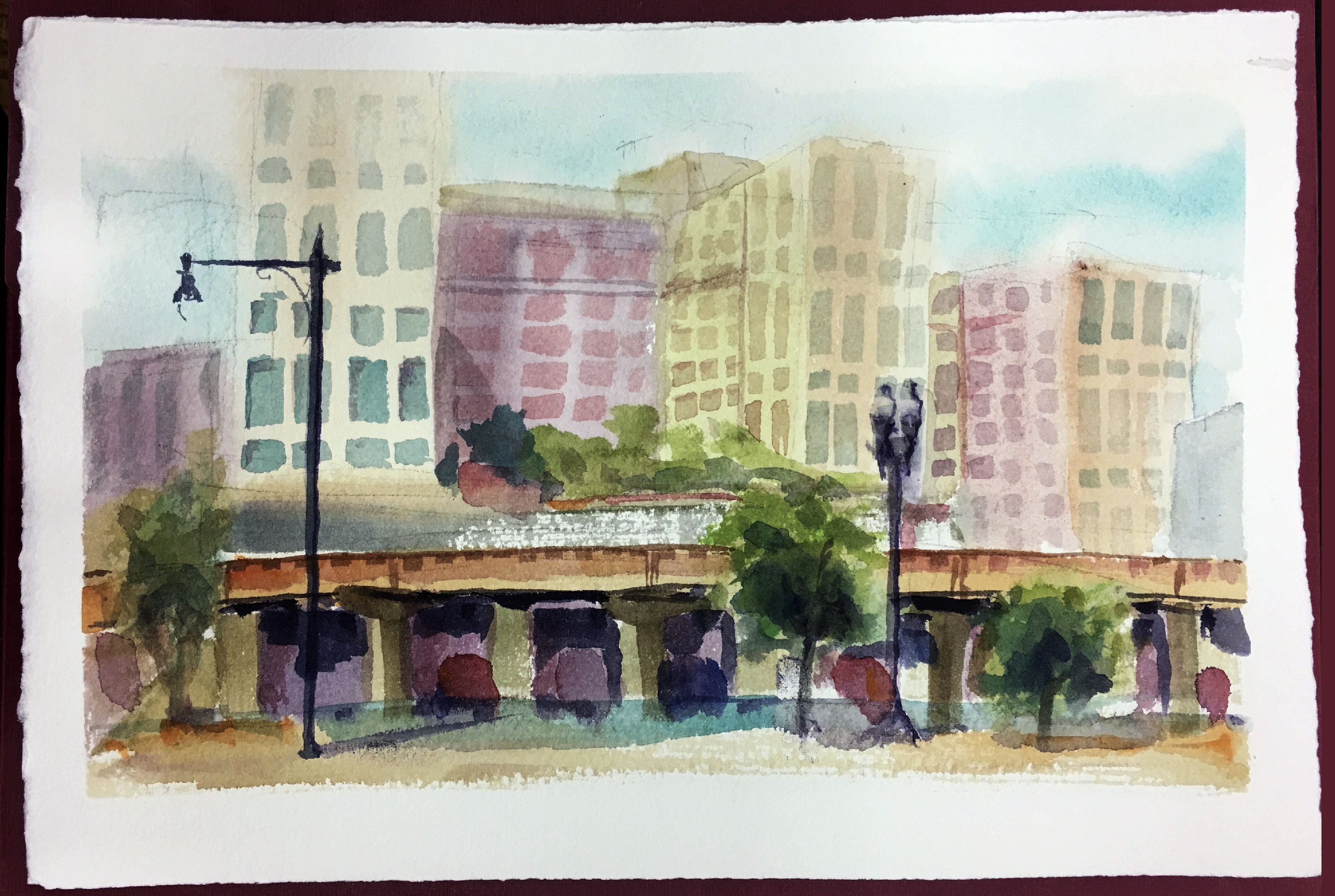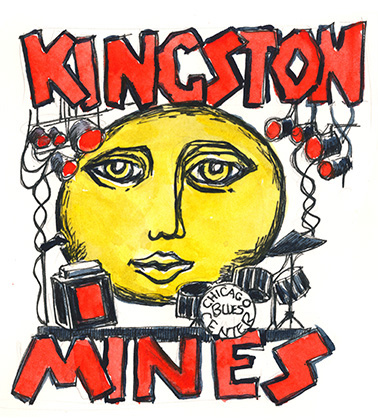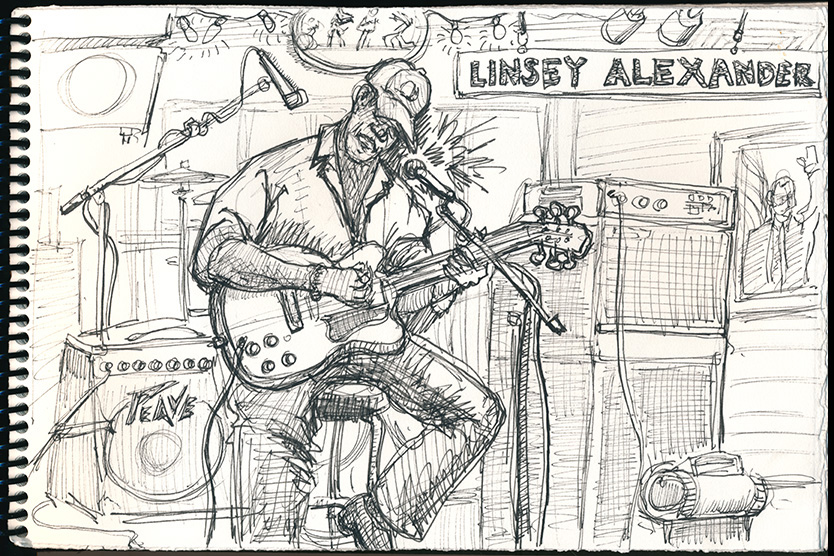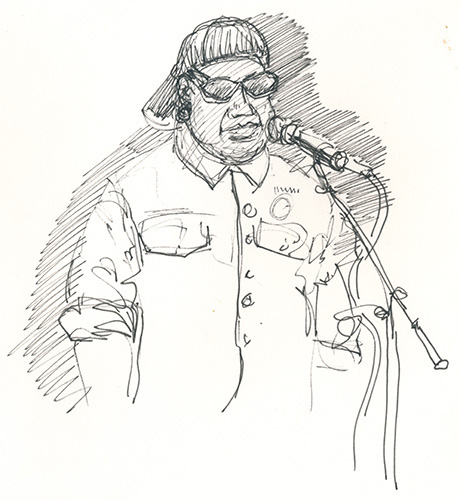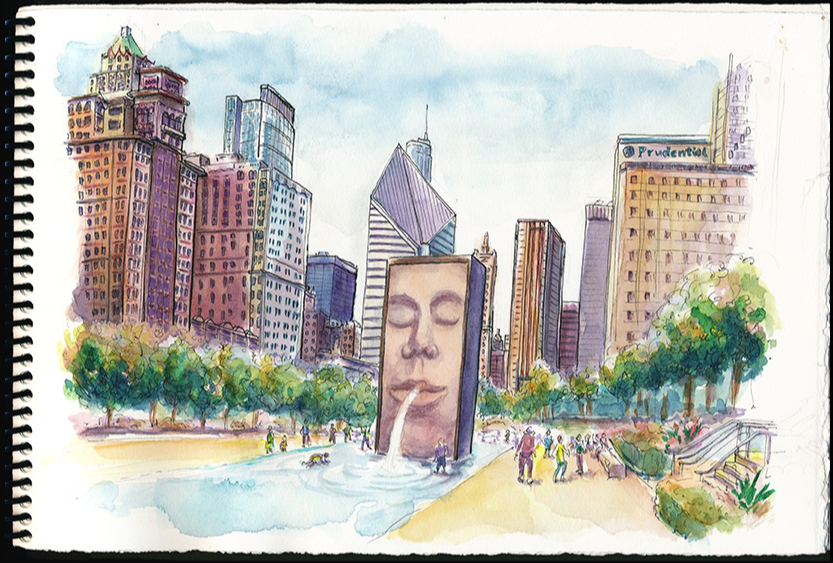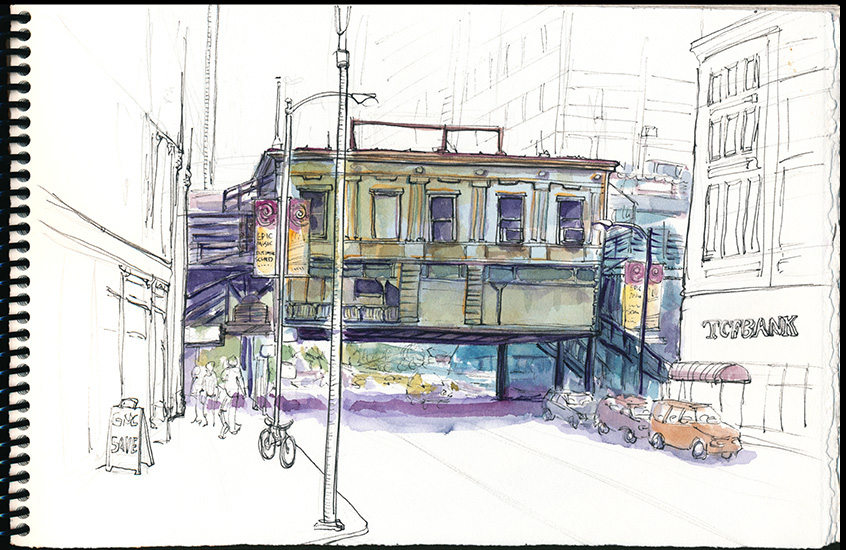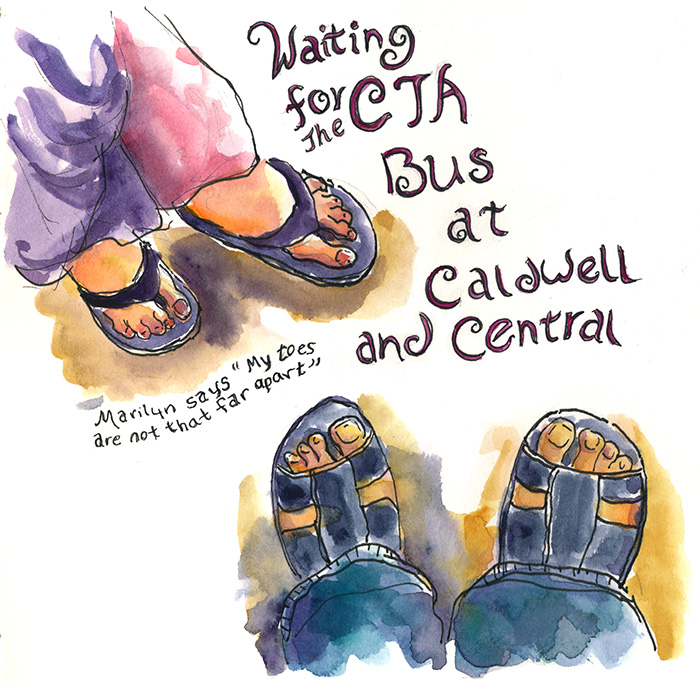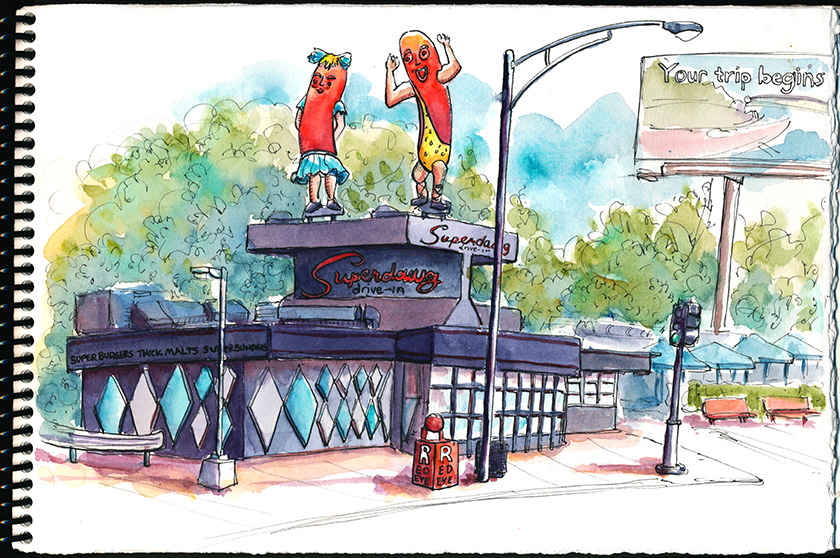Here’s my first sketch from Chicago. This was painted on Wabash Ave and Harrison St. The sketch was submitted to auction to benefit Urban Sketchers. Thanks to Gail Wong for putting in the winning bid!
Category: Chicago
Nineteenth Floor View from the Blackstone Hotel in Chicago
 Accommodations for the Urban Sketchers Symposium can be quite comfortable if you have a friend who’s nice enough to use thousands of accumulated Marriott points. My friend Phil had just enough points to score the Blackstone Hotel, just two blocks from the Goodman Center where the Symposium was centered in downtown Chicago. Thanks Phil!
Accommodations for the Urban Sketchers Symposium can be quite comfortable if you have a friend who’s nice enough to use thousands of accumulated Marriott points. My friend Phil had just enough points to score the Blackstone Hotel, just two blocks from the Goodman Center where the Symposium was centered in downtown Chicago. Thanks Phil!Slice of Heaven
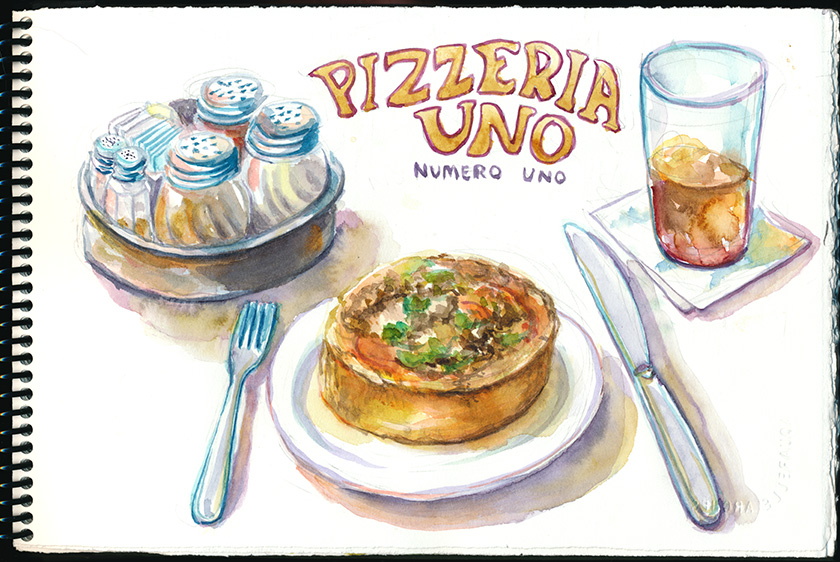
What’s not to love about pizza? The simple combination of warm bread, tangy tomato sauce and melted cheese is irresistible. But pizza is as personal as there are people who love it and its variations are equally boundless. The choices for crust alone are many: thin, thick, crispy, chewy, stuffed, or even fluffy and bread-like. Sauces range from creamy white, green pesto, tangy tomato, smooth or chunky, BBQ, even thai spice. Cheese-wise, Mozzarella, Provolone, Romano, Parmesan, feta, cheddar . . . and the topping list is endless. Some folks even debate about the layering. Cheese on top, middle or bottom? Sauce on top or bottom? Toppings sometimes get placed on the bottom (bottomings?). With so many possibilities, who knew the taste of heaven could be so complicated?
After a day like today of sketching around the city, I’m super hungry and a Chicago style deep dish pizza is what I crave. Just a few blocks away from Millennium Park is the original Pizzeria Uno’s restaurant that opened back in 1943. To get there, we walked a few blocks over to the corner of Ohio and Wabash and I stood on the street corner to start a sketch of the restaurant. After finishing the line work, we entered the restaurant where we found several other couples waiting for a table. The rich smell of pizza made my mouth water. My wife Marilyn leaned over and said, “I’m glad we came here on a Tuesday mid afternoon, there’s hardly anyone here. We asked for a table-for-two and lucky us, one just became available.
We were seated at a front table, with a window view. I couldn’t have been happier. I placed my order for a Numero Uno “the works” pizza with sausage, pepperoni, onions, peppers, mushrooms and Uno’s unique chunky tomato sauce–topped with mozzarella and grated Romano. Then I began to draw my place setting, leaving space to sketch in my pizza when it arrived.
Deep dish pizza was invented in Chicago and Pizzeria Uno’s claims they introduced it to the world. But as with any number-one-claims-to-fame, there are controversies surrounding who actually owns the top spot. But who am I to argue? I just want a great tasting Chicago style deep dish pizza. While I’ve been in Chicago, I’ve made the rounds to pizza restaurants that serve all styles from thin to thick crust. But to simplify things, I like to eat the style of pizza that the region is best known for so while I’m in Chicago, deep-dish rules.
When my pizza arrived, I briefly sketched and photographed the pie, then grabbed my utensils and dove in. Against the knife, the warm crust cracked with perfection, crisp and buttery. The slightly-chunky sauce zinged with piquant spice, the delicious blend of cheeses enriched mouth feel, the fresh vegetables were cooked just right, the pepperoni and sausage enlivened my palette. But pizza is much more than a sum of its parts. Perfect pizza unifies the individual ingredients into a collective whole. This pizza had that balanced quality and was heaven for my taste buds. After savoring each bite ’til the last, I proclaimed Pizzeria Uno’s to be the best pizza I’ve tasted in Chi-town!
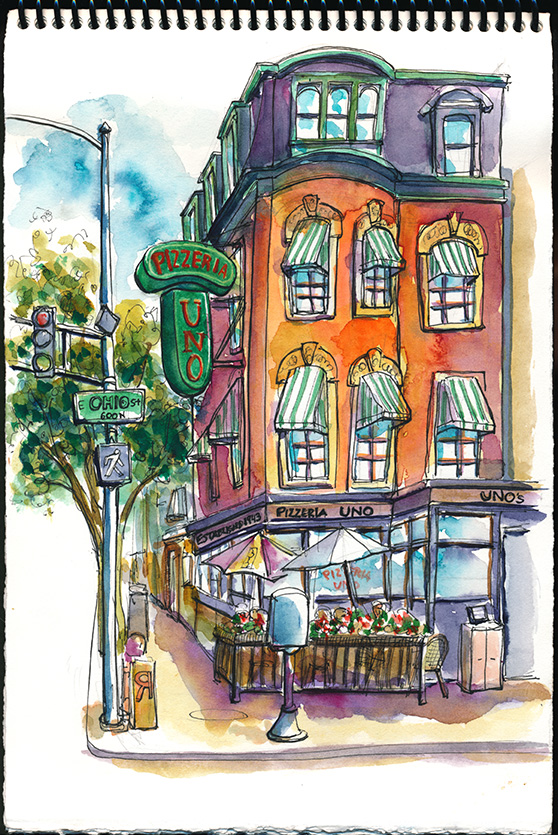
Kingston Mines – Chicago Blues Club
Although there are many clubs in Northern California that play Blues, I didn’t want to miss out on a real Blues experience while visiting Chicago. So on Sunday evening Marilyn and I headed over to Kingston Mines in Lincoln Park, one of Chicago’s oldest and grittiest Blues clubs.
From what I’ve read, the club sprang to life in 1968 out of an old machine shop and originally staged plays and served coffee. The musical Grease first took the stage here in 1971 under the name Greased Lightning before it moved to Broadway. But eventually Delta Blues dominated the club’s lineup and by the late 1970’s, the music evolved into the Chicago Blues style. Though the club books mostly local musicians, the talent has attracted visitors such as Bob Dylan, Robert Plant, and Stevie Ray Vaughan. Mick Jagger, after having come to hear the great Lefty Dizz in 1978, ended up on stage jamming with the band. Even the Blues Brothers performed here while promoting their movie.
We arrived at the nearly-empty club just after opening at 6:15pm and sat close to the stage, at the end of a long wooden table. Neon signs glowed above the bar behind us promoting domestic beers from Pabst Blue Ribbon to Samual Adams, hinting at a diverse clientele. The elevated stage was decorated like a house’s back porch, complete with windows and wood siding. A mural just to the right of the stage further emphasized the illusion of a night out of doors.
Just as we ordered a couple of drinks, Linsey Alexander, tonight’s performer and host for Open Mic, took the stage along with a drummer and bass player. Over the years, Linsey’s played with the likes of B. B. King, Bobby Rush, and Buddy Guy, along with many other Blues greats. When not on the road, he performs regularly at Kingston Mines. Linsey’s casual rapport with the audience, which had built to a couple of dozen of us, quickly became apparent. With a sly smile, he urged musicians to add their names to the evening’s Open Mic roster. “Who wants to come up here?” he asked, adding, “I sure don’t want to be up here tonight.”
After Linsey noodled around on his guitar a bit, he called out to a man leaning on the railing left of the stage and told him, “Hey you there, get a job.” The man shot back, I’ve already got one.” With a laugh, Linsey began playing again, this time with the full band. As the dark room filled with the strains of Pure Blues, I pulled out my sketchpad and drew by the light reflecting off the stage.
After the end of the second song, a man came by our table selling Linsey’s CDs. Spotting me, he called out, “Hey Linsey, this guy’s drawing you . . . and it doesn’t look anything like you either!” Linsey shook his head and said”That figures.” I kept quiet, but smiled and took it in stride. As I’d already begun to understand, the put-downs were part of the fun. If anything, I felt included in the good humored joshing.
More patrons entered the Club, many carrying instruments ranging from guitars to harmonicas, even a washboard. Linsey called out names from the sign-up sheet and a group of six musicians made their way from audience to stage. After set up, a song was selected and the group began to jam. I was blown away by how good they sounded.
As the evening wore on, heat began to rise and the energy of the music changed from casual and effortless, to heavy jamming and pounding rhythms. The Blues are alive and well in Chicago.
Millennium Park’s Crown Fountain
While traveling around the city of Chicago, I’ve seen neighborhoods with eclectic buildings, farmers markets, and beautiful established trees that make them attractive places to sketch. I could spend years capturing this city on paper and never get bored. But so far, downtown Chicago is my favorite place to draw.
The eclectic architecture south of Wacker Drive spans well over a hundred years and includes early skyscraper styles by Louis Sullivan from the late 1800s, contrasted with mid twentieth century buildings by modern architects such as Ludwig Mies van der Rohe. Two of the city’s most famous buildings, the Willis Building (formerly the Sears Tower) and John Hancock Center, both designed by Skidmore, Owings, and Merrill, dominate the Chicago skyline when seen from a far.
In the mid-1980s, the Crain Communications Building, designed by Sheldon Schlegman of A. Epstein and Sons, was built. It’s commonly called the Diamond Building, and was designed to add a feminine appeal to an otherwise masculine skyline.
But it’s not just the architecture that make downtown Chicago interesting. The City has one of the best collections of outdoor sculpture in the world that includes Picasso, Chagall, and Miro. More recently, with the addition of Millennium Park to the Loop area, two new sculptures, Cloud Gate by Barcelona artist Anish Kapoor and Crown Fountain by Catalan artist Jaume Plensa, add to the world class collection.
Crown Fountain is composed of two fifty-foot towers separated by a shallow granite pool, each including one entire wall of LED lights that display the animated expressions of Chicago residents. Water flows along each tower’s facing glass wall, and periodically spouts from the mouth of the displayed face. From my sketching spot, I could see both children and adults wading and splashing.
To my eye, the Crown Fountain towers appear to echo the surrounding architecture, and add a human quality to the shiny blank facades of nearby modern skyscrapers. What a treat to be able to watch the faces of people of a selection of Chicago’s residents, some of whom may even work within those buildings.
Take the L Train
Today Marilyn and I headed to Millennium Park, another downtown attraction worthy of a week’s worth of sketching. After we exited the Red Line train, we walked a few blocks to West Madison Street, then headed east toward Lake Michigan. Here, skyscrapers blocked most of a cloudless sky, shielding us from the scorch of the sun.
Just past State Street, an elevated train bridge caught my eye with its industrial, old world look. We sat down at a Mexican restaurant’s outdoor patio table that provided an unobstructed view of the El tracks. Marilyn ordered us lunch while I held the umbrella-less table. The temps today were edging toward the 90s, but the humidity was low enough to make that bearable. My sketchpad page glowed a pristine white before me as I studied the bridge, a break between tall buildings permitting sunlight.
After devouring a burrito bowl piled high with spicy chicken, black beans, guacamole, sour cream, salsa, and lettuce, I sketched the bridge while keeping cool with a glass of Iced tea.
Since arriving here in Chicago, I’ve done most of my sketching while standing on pedestrian-laden sidewalks, occasionally finding a comfortable spot to lean against a building. It’s not the most pleasant way to draw, but I’m willing to sacrifice comfort for a good vantage point. Today, it was great to have a place to sit and take some time.
The downtown commercial district of Chicago is called The Loop after the elevated train tracks that encircle the area. The L (or El, short for “elevated”) was built in the late 19th Century. The area is home to the historic theater and shopping district, the more upscale Michigan Avenue’s Magnificent Mile stores having gradually migrated a half mile north.
As I put the finishing touches on my drawing, Marilyn commented that she had never paid any attention to the elevated train bridge before now. I reflected on how familiarity with a place makes its details so easy to overlook. That’s what’s so great about being an artist on the road, everything looks new whether it is, or not. In this case, my sketchbook sorely needed a drawing revealing the city’s history and grit. After all, I am in Chicago.
Art in Transit
Chicagoans are proud of their public transit system, the Chicago Transit Authority (CTA), and they should be. Since the late 1940’s, the CTA has been providing a reliable, economical, and relatively safe way of getting around the city. The buses and trains we’ve used while here have been on time, clean, and an enjoyable way to travel.
The arts have long been apart of the CTA history, but not all were encouraged. Back in 1969 there was a rock group called The Chicago Transit Authority but after the CTA threatened legal action because of the use of their name, the band shortened their name to Chicago for their second album.
More recently, the CTA combined efforts with the Arts in Transit Program, and now more than forty CTA stations are permanent homes to mosaics, paintings, and sculptures.
While waiting for the bus to arrive, Marilyn and I played footsie at the station. I started to sketch our feet but it wasn’t long before the bus arrived and cut my drawing time short. Once we found a seat, I used my waterbrush to add some quick color to the line work. The bus took us to a train, which then left us at our final destination, downtown.
Adventures at Superdawg
Although I’m not a huge hot dog fan, I occasionally get a craving that just won’t let up. One afternoon as we drove past the cool vintage sign for Superdawg, a fire was lit in my belly and an image of a hot dog was etched into the craving side of my brain in glowing neon. But it was several days before the opportunity arose for me to satisfy that craving.
As we pulled up to park at the restaurant, I noticed the glowing retro menu at the passenger side. So Superdawg wasn’t just a diner, but a true old fashioned drive-in. Supercool! I hadn’t been to a drive-in restaurant since I was a kid. We parked and I rolled down the passenger side window to read the menu.
The array of choices was dazzling. Not only did they have Superdawgs but they also had: Whoopskidawgs, Whooperburgers, Superchickenmidgees, Supertamales, Superonionchips, Supermalts, and Supersundaes! The selection was a mind spinner, but what made my taste buds really stand at attention was a good ol’ fashioned hot dog with mustard. (In this town, I’m told ketchup on hot dogs happens about as often as peanut butter on eggs.)
I pressed the service button on the Order-Matic to request a Superdawg with fries and a Coke. Ten minutes later, a cheerful carhop fastened a full tray to the driver’s side window.
Marilyn passed me a drink and a cardboard box that, when opened, was stuffed full of ridged fries and, of course, a hot dog. I dove in, and before my wife could ask how it tasted, it was gone. “That was super!” I said. “But without pickles or onions, it’s not a REAL Chicago dog,” she quipped. “I wanted a Superdawg, not a superpickle,” I told her.
What could she say to that? The answer, my friends, is not much. And with that we flipped the tray pick-up switch on the Order-Matic and were on our way.
